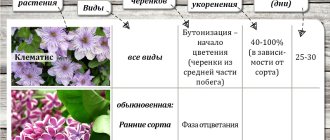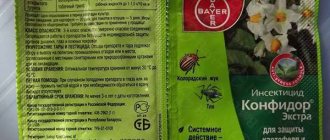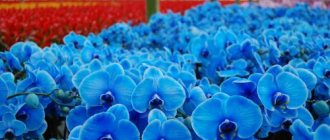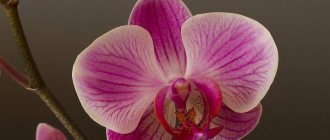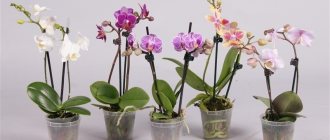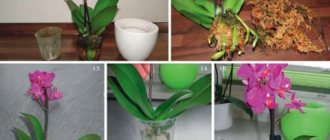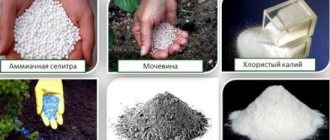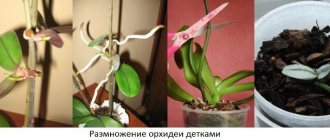- Growth period
Beautiful orchids, mainly various varieties of the Phalaenopsis genus, have long taken pride of place on the windowsills of apartments and private houses. These representatives of tropical flora captivated Russians with the shape of the flower, reminiscent of a butterfly, the variety of colors, the long flowering period, and the availability of purchase. Experienced flower growers know that to maintain a flowering appearance, a plant needs to be provided with a constant temperature, a certain regime of lighting, humidity, and fertilizing. We will tell you in the article what and how to feed an orchid.
Phalaenopsis (pictured) is one of the species most common in home floriculture
Ecological groups of orchids
In nature, orchids occupy different layers of the forest, therefore, they have different attitudes to growing conditions - lighting, humidity, soil nutrition, which must be taken into account when growing them indoors.
There are two groups: epiphytic and terrestrial.
Epiphytes
Prominent representatives: phalaenopsis, vanda, cattleya, dendrobium.
The name “epiphytes” from Greek means “on the plant”: representatives of this group live on other plants (phorophytes), mainly on trees. They are not parasites, since they use the phorophyte only as a place of residence, support, and receive moisture from the air and precipitation. In densely populated tropics, this feature helps them avoid competition for light and soil. Epiphytes, in addition to orchids, include mosses, lichens, and bromeliads.
Epiphytic orchids have free, photosynthetic roots, so they are grown in hanging baskets or clear glass pots.
Plants have little demand for soil nutrition. To provide all the necessary elements, it is enough to add special complex compounds.
Terrestrial orchids
Cymbidium, ludisia, bletilla, playone, and calantha growing in the lower tier of the forest receive nutrition from the rich forest litter, consisting of rotting leaves, grass, and animal excrement. Even at home, land plants require good nutrition, and some, for example, cymbidiums, even require organic matter rich in nitrogen.
Cymbidiums in nature grow both epiphytically on trees and on the ground under them.
Detailed instructions for planting different types of orchids can be found in the article on our website.
Principles of flower maintenance before and during the appearance of buds - what is the difference?
Care in these different periods is of course different, let's compare:
- Care before the peduncle is released - while the plant is resting (not blooming), it needs to be carefully looked after so that it has the strength to bloom for a long time:
You need to water as the roots dry out.- Maintain the required humidity and temperature.
- Lighting must be active.
- Carefully and regularly inspect the flower for pests.
- You should not get carried away with fertilizing, otherwise the Orchid may begin to “fatten”, grow leaves and roots, but not bloom.
If it still doesn’t bloom for a long time, you need to create “stress,” that is, create completely uncomfortable conditions: either move it to a darker place, or create a slight “drought” (dramatically reduce watering). After such actions, flower stalks usually appear.
Read also Shoebox Bird Feeder
- Care during the release of the peduncle is no less thorough; of course, you need bright light, and the air humidity must be appropriate, the temperature regime must be observed, but after the peduncle has emerged, fertilizing should be immediately resumed at the required rate. At this moment they greatly influence the health of the entire Orchid bush in general and the quality of flowering in particular.
Isn't it time to feed?
If there is a nutritional deficiency, the orchid itself will attract attention. The need to apply fertilizers is indicated by:
- long absence of flowering;
- the plant blooms, but the flowers are small and fall off;
- cessation of growth of new leaves or their shrinkage;
- change in leaf blade color (lightening);
- the lower leaves turn yellow, dry out, and die.
It’s easy to guess that it’s time to feed your orchid at home by the appearance of the plant.
What are the consequences of fertilizing a flowering plant?
Should I fertilize the blooming beauty? In this case, only root fertilizing is not done. Ignoring this rule, the plant will drop flowers, and new buds will not form. But foliar feeding continues. Often, inexperienced gardeners wonder why they can’t fertilize when an orchid is blooming? The answer is simple - the flower managed to accumulate all the nutrients it needs before the peduncle appears. During flowering, the accumulated energy of the orchid begins to be consumed .
If you apply fertilizer, this will provoke your pet to refuse flowering in favor of assimilation.
Types of fertilizers
Traditionally, all fertilizers are divided into two groups: organic and mineral.
Organic matter is the waste of birds (pigeon, chicken droppings) and farm animals (manure). Usually an aqueous solution of rotted horse manure is used. But this is not always feasible. At home, the easiest way to feed orchids is with complex mineral fertilizers. Today, flower shops offer a good selection of compositions. From time to time you can turn to folk and specialized remedies. Their characteristics are presented in the table:
| Fertilizer type | Name and composition/purpose | Method of preparing the working solution and applying |
| Mineral fertilizers | Agricola Aqua , Pocon, Bona Forte , Flower Paradise , Fasco Complex preparations, including three main macroelements (nitrogen, phosphorus, potassium), microelements, amino acids in the concentrations required by plants | Detailed information on the preparation of the solution, dosages and methods of feeding is indicated in the instructions for the drug |
| Folk remedies | Banana peel Contains potassium, phosphorus, calcium, amino acids | The peel of one banana is poured with a liter of warm water and left for a day in a dark place. Water at the root, having previously diluted the nutrient solution with water 1:1 |
| Potato peelings Contain potassium, magnesium, nitrogen, phosphorus | Raw peelings are poured with boiling water, cooled, and filtered. Water at the root | |
| Garlic infusion is rich in vitamins and phytoncides that kill phytopathogens | 2 cloves of garlic are crushed, pour in 2 liters of water, leave for a day, filter and water at the root | |
| Sugar and yeast Sugar glucose and B vitamins contained in yeast are excellent flowering stimulants | 10 g of dry yeast (bag) and 3 tablespoons of sugar are diluted in 10 liters of warm water, left for 2 hours. Pots with plants are placed in the bathtub and watered abundantly | |
| Specialized means | Succinic acid Reanimation after stress, regeneration in case of damage, stimulation of leaf growth, root formation, flowering, soil improvement | The tablet (sold in pharmacies and gardening stores) is crushed and dissolved in a small amount of hot water. The resulting solution is added to 500 ml with water. Used for root and leaf irrigation, root treatment during transplantation |
| Cytokinin paste A hormonal agent that accelerates the appearance of inflorescences and children | In the spring, after removing the covering scales, the paste is applied pointwise to the waiting buds of the peduncle using a toothpick or a cotton swab. At the same time, the plant is fed with nitrogen. After 2 weeks the bud begins to grow | |
| B vitamins : B1 (thiamine) – stimulates root growth, accelerates flowering, increases flower size; B3 (nicotinic acid) – reanimates, accelerates flowering and the formation of new shoots; B6 (pyridoxine) – increases immunity, facilitates adaptation; B12 (cobalamin) – improves oxygen saturation, promotes the development of new flower stalks | Use a solution of 1 ampoule of any vitamin and a liter of water for watering and spraying once a month. |
There is a wide range of products on sale in different forms and volumes of domestic and foreign production.
Specialized fertilizers for orchids are preferable to universal complexes for flowering indoor plants, as they contain reduced concentrations of elements that can burn the roots.
Which is correct?
Under natural conditions, orchids receive additional nutrition from dew drops. Therefore, when kept indoors, it is better to use liquid fertilizers.
It is necessary to feed taking into account the following recommendations:
- water the plant generously 2 days before the procedure;
- the solution temperature must be at least 40 degrees;
- the proposed dose should be halved;
- The flower should remain in the nutritional composition for no more than 15 minutes.
Next, you need to carefully examine the leaf axils. If there is an accumulation of drops there, blot them with a napkin.
Attention! After the procedure, the orchid must be protected from drafts and contact with direct sunlight.
How often?
In the process of applying fertilizers, it is necessary to take into account the seasonality factor and the condition of the soil substrate. Depending on this, the frequency of feeding is selected:
- Recently transplanted specimens require more nitrogen fertilization. But you can feed them only after a month.
- If there is drainage made of synthetic materials in the substrate, the flower will require feeding more often. And with the predominance of natural materials, it is enough to occasionally add phosphorus.
- In winter, orchids are not fertilized. In the fall, you can feed them once a month, but this is not necessary.
- In spring and summer, metabolism is activated. During this period, plants are fertilized twice a month.
A certain microclimate gradually forms in the soil and minerals accumulate. The more an orchid grows in one substrate, the less it needs additional nutrition. Otherwise, the soil will become salty and the roots will die.
When is it possible and not?
The flower needs feeding during the growing season. In the spring it is fertilized to grow foliage and accumulate strength for flowering. In summer, the plant is provided with additional nutrition until the first buds appear. And in the autumn, foliar feeding can be done if the orchid continues to bloom.
But plants are not always ready for this procedure. They cannot be fertilized in the following cases:
- when the flower is weakened after transplantation or pest attack;
- during illness;
- immediately after purchase, since the substrate still contains enough micronutrients;
- in extreme heat.
It takes about a month for an orchid to adapt to a new place and microclimate. After this period, fertilizers can be applied.
Rate this post
Stages of fertilizing
During certain phases of the life cycle, plants need different nutrients.
Growth period
During the period of active growth, orchids are fed with fertilizers with a high nitrogen content, which promotes the growth of green mass.
If you overdo it with the application of nitrogen, the plants will begin to “fat”, growing new leaves rather than flower stalks.
Budding phase
At the stage of laying new flower stalks and at the budding stage, the flower needs potassium and phosphorus.
Phosphorus-potassium fertilizers are considered a priority, as they contribute to the active formation of large buds and bright colors of flowers
Flowering period
During flowering, you can add potassium and trace elements. If the plant was not fertilized before the buds began to bloom, then there is no need to feed it, otherwise it will quickly bloom or begin to shed flowers and buds.
Rest period
Orchids survive winter in the dormant stage, which is facilitated by short daylight hours and lower air temperatures than in summer. This is when new flower buds are formed. You need to fertilize no more than once a month with a universal complex.
Phalaenopsis can bloom throughout the year, releasing arrow after arrow, which means they will have to be fertilized constantly
I will give an example of my first experience in growing phalaenopsis. A flower given for my birthday (presumably the Atlant variety - with a dark pink, closer to fuchsia, corolla color) occupied the kitchen window facing west, where it bloomed almost non-stop for two years. Then he had to go through two moves.
In a new apartment on the north-west window, the orchid tried to put out an arrow, but flowering did not happen: the buds fell off, the peduncle itself dried up, then the lower leaves began to die off (only 3 left). For three years I revived it: I sprayed it, in the summer I sent it to the open balcony (the same side of the world), I fed it along with other fertilizers for indoor flowers, which, as it turned out later, was completely wrong. And only a special fertilizer for orchids gave results: the phalaenopsis produced new roots, leaves and began to bloom again, which it now does regularly, but intermittently. I buy different types of Agricola (powder) for my plants - inexpensive but effective.
Does an orchid need feeding during flowering?
An orchid must be fed during flowering. Only strict adherence to the rules for applying fertilizers will create favorable conditions for the normal development of the plant and its further flowering. Although it should be noted that experienced flower growers often disagree on how often a flowering orchid should be fertilized: some believe that the plant spends a lot of vitality on flowers, so it simply needs to be supported, while others argue that it is better to avoid fertilizers during the flowering period , as they can significantly accelerate wilting.
So, is it possible to feed an orchid that has begun to bloom? We advise you to find a compromise between two points of view: definitely apply fertilizer, but observe the measure and certain restrictions, which will be discussed below.
Methods and rules for applying fertilizing
The general rule for applying fertilizers is to pre-water the plant. Orchids are fed by root and foliar methods.
Fertilizers must be dissolved in settled water at room temperature.
Root feeding is carried out by watering the roots or immersing them in a solution. To do this, lower the pot with the orchid into a container (small basin) with a fertilizer solution for 10-15 minutes.
Foliar (leaf) spraying involves spraying the leaves on both sides with a solution from a spray bottle in the morning or evening. It is important not to get it on buds, flowers or in the axils of leaves. Foliar feeding is characterized by rapid results.
Is it possible to fertilize if the plant is blooming?
You can feed an orchid, but there must be a proper time for this.:
- With the onset of spring, when the flower is growing in full swing and gaining strength.
- In the summer, with the active continuation of leaf growth, but before the appearance of the first bud.
- When the plant blooms, the root feeding is replaced by foliar feeding.
- During the autumn flowering period, fertilizing is allowed only on the leaves and surface roots.
- With the arrival of winter, the plant goes into hibernation and the time of rest begins, so the flower is not fertilized. But many orchids do not always have pronounced dormancy. Still, they need rest.
When not to fertilize
Feeding is strictly contraindicated in the following cases:
- A newly purchased or gifted flower should be given at least 2 weeks time to adapt and only then begin caring for it according to all the rules.
- Immediately after the transplant. No matter how carefully the plant is transshipped, the roots will inevitably be damaged and will not be able to absorb the nutrient solution, which means that the elements will precipitate in the form of salts.
- It is better not to feed sick or weak plants; foliar feeding is acceptable.
- To avoid burns on the leaves, foliar feeding is not carried out in sunny weather.
What to do if the orchid has never been fed?
Let's say you just recently purchased this beautiful flower or simply haven't come across any information about fertilizing. Don’t worry - if your orchid feels great, then start introducing fertilizers during the specified period according to the rules provided. By the way, if the orchid’s root system has rotted or the flower has been affected by pests or has unhealthy symptoms, then you cannot feed it!
Features of feeding orchids - stages and fertilizers
Stages and fertilizers for orchids vary. You will now learn how to combine them correctly. Feeding begins from the moment the vegetative mass of the flower increases - in early or mid-spring, when the orchid begins to grow, we add nitrogen components to the soil. From the moment the buds actively open, nitrogen can cause harm. In order to strengthen the flower stalks and prolong the flowering of the orchid, we apply phosphorus-potassium fertilizers.
Types of fertilizers for orchids:
- Root liquid;
- Foliar sprays;
- Dry;
Of the popular liquid fertilizers , which are poured into the orchid substrate or lowered into the pot with a special dispenser spout, the universal “Mr. Color” has proven to be the best. Use 1 cap per 3 liters of water.
Sprays for orchids "Doctor Foley" are also an excellent help for gardeners. They are used as a lightweight additional fertilizing with basic fertilizers, as well as to restore the root system or for systematic diseases: lack of microelements, chlorosis, wilting due to improper care.
Dry fertilizers for orchids are highly effective, modern feeding options. Dry fertilizers are provided in the form of granules, sticks, tablets . They often contain an exact dosage, but gardeners still advise controlling it, for example, breaking the sticks and using half in the ground.
How to fertilize : in the absence of direct sunlight and drafts, at a temperature not lower than +17° C, during the period of flowering and active growth.
↓ Write in the comments which fertilizers suit your orchid.
Please rate the material you read :)
Features of mixtures for fertilizing orchids
The difference between the special mixtures that are used to feed orchids is their composition, which includes only the minerals necessary for phalaenopsis. Therefore, it is advisable to purchase fertilizer for orchids, which has the following distinctive features:
- includes components that prevent the accumulation of salts in the bark
- with an acidity level in the range of 5-7 pH, since lowering or exceeding this indicator will not allow the substrate to absorb all the necessary microelements and release them to the root system of the plant
- the presence of additional vitamins, succinic acid and amino acids that promote active and healthy growth of tropical flowers
- with a reduced concentration of all nutrients, in contrast to a universal fertilizer for all other plants
Such characteristics of the optimal fertilizer for orchids should be a reason to purchase a separate bottle and not use any other mixtures. In addition, it is the liquid composition that is most suitable for feeding phalaenopsis, since any other forms of fertilizer will be less dissolved and absorbed into the substrate.
How to fertilize an orchid
In addition to mineral preparations, do not forget about organic products:
- thicker than drunken coffee;
- tea leaves;
- bird droppings;
- banana peel.
These funds can be used, but according to the recommendations of specialists. Coffee grounds must be calcined in the oven before use. It will increase the looseness of the soil.
Pure black tea brewing will act as a natural fertilizer. Banana peels can be infused with water, dried or dried.
Chicken manure must be diluted with water so that the final concentration of the solution is no more than 0.05%.
The following are complex factory-produced products that can be used to fertilize orchids:
- "Mr. Color Universal";
- "Fertimix";
- "Doctor Foley";
- "Green Guy"
In flower shops you can see other preparations for feeding your blooming beauties.
How long does the peduncle of a phalaenopsis orchid grow?
From the beginning of the growth of the peduncle to the opening of the first buds, it usually takes about two months. The duration of peduncle growth depends on the light: the more light, the faster the peduncle forms.
If you took my advice and did not cut off the peduncle completely after the end of the main flowering, then with the arrival of autumn, a lateral peduncle may begin to grow from the “dormant” buds of your orchid. Keep in mind that the lateral peduncle forms faster: as a rule, a month after the lateral peduncle begins to grow, the orchid will already delight you with its flowering.
Improper care and its consequences
With proper care there should, in principle, be no difficulties or problems, but, unfortunately, this is not always the case:
- firstly, it is not always possible to create ideal conditions for the plant to send out flower stalks (read about why an orchid does not put out flower stalks and how to force it to do so);
- secondly, there is a problem in the lack of enough time for care.
Most often, the plant can be harmed by:
Spider mites - an unpleasant white coating appears on the leaves, a thin cobweb, it is noticeable along the edge of the leaf. This indicates insufficient air humidity; the flower needs to be thoroughly bathed in the shower (only warm), allowed to dry, and then treated with acaricides.- Scale insects are white in color and look like small white lumps on the leaves. You need to clean them off the leaves as soon as possible (you can use alcohol-soaked cotton wool) and then treat them with insecticides.
- Whitefly is a dangerous “butterfly” that can practically destroy a plant. You must first bathe it in a warm shower with laundry soap, and then also treat it with insecticides.
- Thrips are capable of infecting both leaves and flowers at once; they pierce the edges of the leaf with their proboscis and suck out the juice, the leaf begins to turn yellow. You urgently need to put the plant under the shower, thoroughly rinse each leaf and flowers, and then treat it with Aktara.
Read also The largest variety of anthurium
The most common diseases due to improper care:
- Rot is a fungal disease; you must immediately remove the affected leaves and sprinkle the cuts with charcoal. The reason for this is a lot of moisture at low temperatures.
- Fusarium - the leaves soften and become covered with a pinkish coating, spots appear - treatment with Fundazol (within a week) will help. The reason is stagnation and too much air humidity.
- Powdery mildew - a white coating appears on the leaves and buds; treatment with a solution of colloidal sulfur or the drug "Skor" will help. The reason is the creation of a “greenhouse effect,” that is, too high a temperature and humidity.
- Spotting on leaves - the appearance of dark wet spots indicates that you are too carried away with fertilizing. The leaves will have to be removed and the flower treated with a fungicide.


